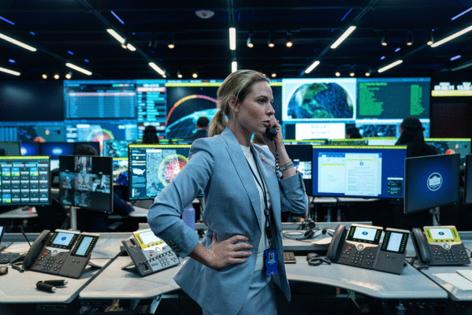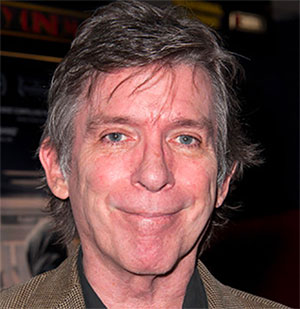In Kathryn Bigelow's new film, Chicago is the target of a nuclear attack. Does the movie reflect reality?
Published in Entertainment News
CHICAGO — If the Doomsday Clock is a symbolic representation of how close the world is to destruction, in Kathryn Bigelow’s Netflix film “A House of Dynamite,” the ticking clock is no symbol. It is very real.
A fictional “what if” about an impending nuclear attack (spoilers ahead), the movie depicts what happens when a missile is launched by parties unknown. Its destination: Chicago. National security and military experts, along with the president, have only 19 minutes to address two questions: Can the missile be shot out of the sky before it hits? And if not, should the U.S. retaliate? The story ends just before impact.
Ironically, the actual Doomsday Clock is located in … well, Chicago. It’s in the lobby of the Keller Center at the University of Chicago, which is where the Bulletin of the Atomic Scientists also is based. The latter is an organization founded in 1945 by people involved in the Manhattan Project. “These were scientists who worked on the first sustained nuclear chain reaction,” says Daniel Holz, “They realized that this technology was incredibly dangerous and could lead to the end of civilization, so they created this organization to warn people — to warn society and to warn policymakers.”
Holz is a professor at the university, as well as chairman of the science and security board of the Bulletin. He also runs the Existential Risk Laboratory, which seeks to understand and mitigate existential and global catastrophic risks.
The Doomsday Clock has been around since 1947, and the time on its countdown can move backwards and forwards, depending on how optimistic or pessimistic the outlook is. The clock is currently set at 89 seconds to midnight. “It’s the closest we’ve ever been to midnight in the history of the clock,” Holz says. Initially a gauge of the threat posed by nuclear weapons, it has expanded to include concerns about climate change, artificial intelligence, mis-and-disinformation and pandemics.
With Chicago being the birthplace of nuclear weapons, seeing it become the target of a nuclear attack in a movie functions as a terrible bookend, courtesy of Hollywood. “Probably most people in Chicago don’t think about the fact that their city played a key role in the unleashing of nuclear dangers,” says Alexandra Bell, who is the president and CEO of the Bulletin, and former deputy assistant secretary for nuclear affairs at the State Department.
According to the International Campaign to Abolish Nuclear Weapons, the countries that have nuclear weapons are: The United States, Russia, China, France, the United Kingdom, Pakistan, India, Israel and North Korea.
“Most of the time, Hollywood gets the nuclear issue wrong,” Bell says. “It’s usually a MacGuffin to move the plot along. It’s been a long time since Hollywood put out a movie that really just deals with the threat that nuclear weapons present each and every day, but I’m not surprised by that — the world moved on, too. At the end of the Cold War, everyone sort of wiped their hands and said, ‘Ugh, glad we finished that particular problem’ and put their focus elsewhere. Putting the nuclear threat front and center wasn’t something people thought was necessary because post-Cold War, we had managed that threat and came out on the other side.”
“A House of Dynamite” punctures that illusion. The following conversation has been edited for clarity and length.
Q: In the movie, a single missile is launched. Is that likely, just a lone missile?
Holz: The term for that is a “bolt out of the blue” attack and it is something people do talk about and worry about. The question of why you would do that is unclear and it’s not considered the most likely event, but there are nations that could do this, for sure, right now.
I think of it as a planet-level catastrophe if we get this wrong, so “that doesn’t seem likely” doesn’t reassure me. There are leaders who, we don’t know what’s motivating them, but what we do know is that for any reason, at any moment, if they decide to launch a nuclear weapon, they can. You can launch these missiles from submarines where you surface for a minute and then disappear under the ocean, but a U.S. president will be under pressure from the Pentagon to retaliate even if we can’t be sure who launched the missile. There’s a whole infrastructure to make sure we respond.
This is the system we’re in, where people have been trained to immediately say, “If we’re under nuclear attack, we need to respond.” There’s a lot of fog of war. You get, like, 10 minutes to decide. And if you make the wrong decision, the consequences can be catastrophic.
Q: What does it look like if a single missile hits Chicago?
Holz: There are a whole bunch of ways that weapons destroy things. If it hit the Loop and you are within three miles of that, you would experience a giant fireball much hotter than the sun and you would just vaporize. It all just goes away. If it happened while I was in Hyde Park at the university, which is eight or 10 miles away, and I was out in the open, I would get burned. If I were inside, I might initially be OK.
But what happens next after the detonation is a huge firestorm, and that can kill easily as many people, if not more, than the initial explosion, and in a much larger radius. Anything that’s flammable catches fire. And once fires start to go, they grow. And that happens within minutes.
And then of course, everything is radioactive and you have radioactive fallout. So even people who survived the initial blast and the resulting fires are likely to get radiation poisoning and die within the next few days and weeks.
One of the major misconceptions people have is we’ll just shoot down the missiles when they come. Shooting down a missile that’s coming from a couple of hundred miles away, like with Israel’s Iron Dome system, is one thing. Shooting down a missile that’s coming down on your head from outer space and going many, many times the speed of sound is a much, much harder problem. And we have not solved that problem.
Q: Bloomberg obtained a recent Pentagon memo that had concerns about the film’s portrayal. According to the memo, the U.S.’s missile interceptors have “displayed a 100% accuracy rate.” In the movie, the success rate is said to be about half that. One character says it’s like “hitting a bullet with a bullet” in terms of difficulty.
Holz: That was one of the things I think the movie got wrong, in the sense that the number they give is very optimistic! I think the quote is that “it’s a coin toss”? Those numbers are based on scripted tests where the interceptors know when the missile is going to come in and everything is kind of perfectly arranged to maximize success. And in those cases, maybe you hit it half the time.
But it’s never been tested in what you would consider a real scenario.
So that whole thing about shooting down an incoming missile, we would love to be able to do that. We’re not in a position to do that now. And it’s very unlikely we will be able to do that in the future. So we have to prevent this in the first place.
Q: The movie operates under the assumption that there’s a base level of competence of the people involved. But we know that in reality, many in both the military and government with extensive experience and knowledge have been removed from their posts, or have left of their own accord. So this idea of assuming competence doesn’t sync up with reality right now.
Holz: I completely agree. Let’s do a quick “true or false” on the film. Would it really happen this quickly? Yes, that’s true. Does missile defense work 61% of the time? No, that’s false, it’s much worse than that. Let’s get to your question: Are there adults in the room that will save us? And I would say that’s doubly false.
Take John F. Kennedy and Nikita Khrushchev. They both were absolutely not going to start World War III over the Cuban Missile Crisis. They made it very clear in their diaries and in speaking with people, they would have absolutely capitulated rather than launch missiles. But they ended up very close to launching missiles anyway through miscommunication and misunderstandings. The whole thing is terrifying.
So even in the best of cases, it’s extremely dangerous. And I think an argument can be made that right now we’re not in the best of cases. We don’t have very informed, deliberate decision-making at the top.
Q: The movie feels somewhat out-of-date because it doesn’t consider how AI might impact these moments of crisis and the potential risks involved with that, since AI often provides false information.
Holz: There’s an increasing amount of information that needs to be processed quickly and all that stuff is going to be done through AI systems. So AI will be part of any decision-making, whether we like it or not. All AI has to do is get it wrong once and it’s catastrophic. And AI is embedded into everything, including military systems.
Bell: Governments around the world, including the United States, are behind the curve in reckoning with the effects of emerging and destructive technologies. AI is at the forefront of that.
The U.S. has been quite careful about the incorporation of AI into nuclear command and control structures for this very reason. That’s the good news. The bad news is that if you were to incorporate these kinds of technologies and things go wrong, you could potentially end up with a scenario where an AI tool hallucinates a threat.
But you don’t need AI to get into that kind of scenario. During the Cold War, we had systems go awry that misinterpreted a particular threat as a full-on first strike. So even before AI, the tools we were using were fallible.
We’ve set up a system that’s reliant on mutually assured destruction and eventually our luck is going to run out, whether it’s through AI or human error, or bad judgment by the nine men who control nuclear weapons.
Q: Hollywood has tackled concerns around nuclear weapons in everything from 1964’s “Dr. Strangelove” to 1983’s “War Games” to the recent Hulu series “Paradise.” Is there one that you think asks people to think about things in a different way?
Bell: Anybody who has worked for me over the years, from interns to researchers, I always make them watch “Dr. Strangelove.” Stanley Kubrick wasn’t asked by the studio to make a farce, but he read through the source material and thought, “This is a farce.” But the absurdity is real. I’ve been in rooms where you hear lines that are straight out of the movie in terms of disregard for the death toll. These are conversations that largely happen in a theoretical fashion because, thankfully, we’ve never fought a nuclear war. But the theorizing that has gone on can become rather clinical and divorced from reality and I think that’s something Kubrick really keyed into.
Holz: For me, it’s “Fail Safe” (from 1964, directed by Sidney Lumet and starring Henry Fonda), which shows that sometimes things go wrong because these systems are all fallible.
There isn’t a lot of trust or good communication right now, so within that climate, little mistakes can rapidly metastasize into disaster. Nations need to work together to reduce these particular threats, and they just aren’t.
There’s one remaining treaty governing nuclear stockpiles. It’s called New START and it’s the last treaty governing the Russian and U.S. stockpile and it expires in February. If nothing happens between now and then, and it looks like that will be the case, then for the first time in over 50 years, there will be nothing governing nuclear weapons. At all. We will be in a completely unrestrained nuclear arms race again. So there really is a fundamental change in what’s happening right now. And it’s not just Russia, but it’s also China with a growing stockpile.
Q: Does having a deeper knowledge about the risks than the average person keep you up at night?
Holz: My sleep has been getting worse, I have to say. I used to be much better at compartmentalizing. I work on astrophysics, that’s my day job, and that is my refuge: I think about black holes. It’s very exciting, what we’re learning about the universe. So I can kind of escape there. But it’s a very scary time. It just is. The world is very unsettled.
------------
©2025 Chicago Tribune. Visit at chicagotribune.com. Distributed by Tribune Content Agency, LLC.
















Comments